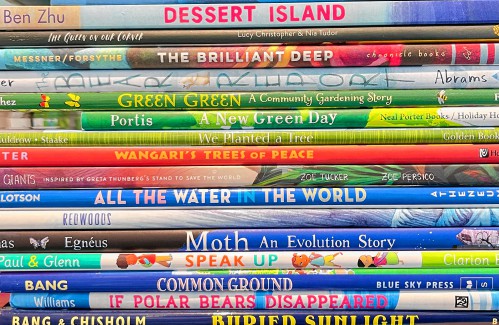Talking to kids about the climate crisis can feel overwhelming. Where do I start? What if I make them worry?
Picture books take major events and otherwise scary topics and pack them into 32 pages or so of art, context and connections we share together. Picture books — along with novels and comics — are incredible tools for generating empathy and can help in climate conversations by keeping us focused on facts, empowerment and action.
In her essay, “Mirrors, Windows, and Sliding Glass Doors,” education professor Rudine Sims Bishop explains: “Literature transforms human experience and reflects it back to us, and in that reflection we can see our own lives and experiences as part of the larger human experience.” Children look to literature as a means of self-affirmation — as mirrors of themselves, windows into other worlds, and sliding glass doors that invite you into these worlds.
When we feel connected, empathy tends to come more easily. As windows, mirrors and sliding glass doors, picture books teach compassion for the most marginalized on our planet whose lives are already changed by the climate crisis: underserved and unhoused people, children around the globe — even endangered animal populations.
As you look for books about climate, seek out titles by Indigenous creators and activists doing the work, and lead conversations with compassion. Don’t shy away from the fact that climate change does and will affect all of us, and that we all deserve a safe and healthy future.
Choosing picture books about climate change may seem straightforward — just go to the science or nonfiction sections and grab books with lots of text and data. But it’s not so simple: Each reader has a preferred balance between text and image that lets them surrender to a story and let it carry them away.
Data-rich picture books like “What a Waste” (French) and “A Kid’s Book about Climate Change” (Artis/Greenspan) fit well for children who sit with books for long hours. Others will be drawn to Rahele Jomepour Bell’s vibrant illustrations in “To Change a Planet” that author Christina Soontornvat wrote to “explain climate change to [kids] with truth and also with hope.”
Children who struggle with anxiety and older readers may find it easier to approach climate change through the sliding glass door: escaping to alternate futures and worlds to learn more about their own. Graphic novels “AstroNuts” (Scieszka/Weinberg) and “CatStronauts: Mission Moon” (Brockington) send hilarious heroes to find other planets to support human life. “The Marrow Thieves” (Dimaline) and the Island Book series (Dahm) question and condemn the colonization of “new” lands, challenging readers to learn about their past and refuse to repeat it.
Once they know how and why the world is changing, readers can learn why its beauty is worth saving.
“The Bear Report” (Heder), “Many: The Diversity of Life on Earth” (Davies/Sutton), “Where’s Rodney?” (Bogan/Cooper), and “My Ocean is Blue” (Lebeuf/Barron) share the majesty of the outdoors and get kids up close and personal with the biodiversity of our planet. Child characters in “Hoot” (Hiaasen), “Zonia’s Rainforest” (Neal), and “Luz Sees the Light” (Davila) get inspired and involved in environmentalism.
Humanity’s future depends on shedding the perfection and individualism demanded by white supremacy and capitalism and building a society based on mutual aid.
Mutual aid is the exchange of resources for mutual benefit — taking responsibility for community care to change political conditions. Books like “We Are Water Protectors” (Lindstrom/Goade), “I Have the Right to Save My Planet” (Serres), and “Green Green: A Community Garden Story” (Lamba/Lamba/Sanchez) remind readers that change starts with us.
Youth may not feel empowered because they cannot vote or run for office, but they can change the world by speaking against injustice and sharing food with a neighbor. “The Queen on Our Corner” (Christopher) and “Our Little Kitchen” (Tamaki) challenge kids to share resources and see value in everyone around them, including people who happen to have less than they do.
“Milo Imagines the World” (Robinson/de la Pena) and “Dessert Island” (Zhu) teach readers how privilege and bias can dictate and distort our view of the world. “Better Than New / Mejor Que Nuevo” (Broder/Buckley) and “I Like Old Clothes” (Hoberman) are about reducing, recycling and seeing the potential in used items. If adults leave children with a planet to grow old on, kids can build a more hopeful society that prioritizes the collective good.
Picture books about honoring and unpacking big feelings can prepare us better for hard conversations and practicing empathy. “The Girl and the Wolf” (Vermette/Flett) and “What Do You Do with a Problem?” (Yamada/Besom) show kids they have courage and strength inside them that will only get stronger as they grow. “Here and Now” (Denos/Goodale) and “Your Mind is Like the Sky” (Ballard/Carlin) can guide that growth through mindfulness. “After the Storm” (Stemple/Yolen) reminds us that rough times end, and our loved ones are there to help us.
Our youngest generations inherit what we leave behind: let that be love and respect for the natural world, and tools to build communities of care and hope. And picture books are here to help!
Allie Martineau (she/they) is the communications and marketing coordinator at the Hitchcock Center for the Environment, and an artist and book reviewer with a master’s degree in writing for children from Simmons University. She thanks friends in the Eric Carle Museum Bookshop for help assembling the booklist for this article, which you can find in full at hitchcockcenter.org along with the works cited.
Earth Matters has been a project of the Hitchcock Center for the Environment for 13 years. Amid the pandemic, the Hitchcock Center adapted its programming and has a sliding-scale fee structure for families facing financial challenges. To help the Hitchcock Center during this difficult time, consider a donation at hitchcockcenter.org.



